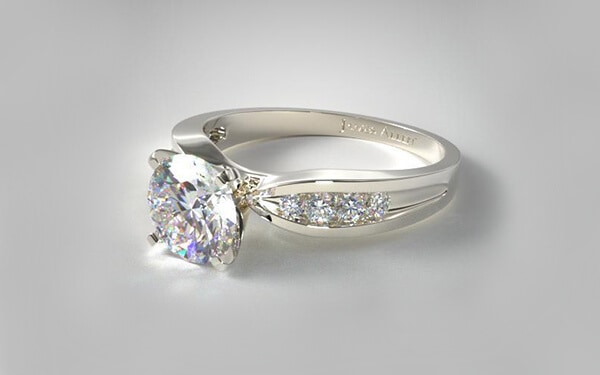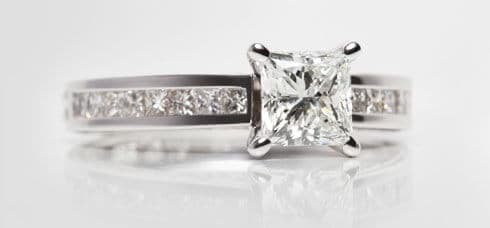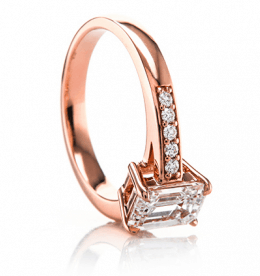Channel set engagement rings feature a row of small gemstones, typically diamonds, set within a channel or groove in the band. This design ensures that the gemstones are bordered by two bands or rows of metal, eliminating the need for prongs or bars to hold them in place. This results in a clean, uninterrupted sparkle. Princess-cut stones are commonly used in channel settings, though other shapes can be used as well.
One of the standout benefits of channel set rings is the enhanced sparkle they provide. The closely set accent stones create a brilliant effect, and because these stones are generally more affordable than a larger center stone, you can achieve a dazzling look without breaking the bank. Moreover, the design’s inherent security means there’s a reduced risk of losing any accent stones, making it ideal for daily wear. Cleaning is also more straightforward, as the absence of prongs prevents dirt and debris from getting trapped.
In terms of budget, the price of a channel set engagement ring can vary based on the number and size of the accent stones. However, by adjusting these factors, you can find a design that offers maximum brilliance while staying within your financial means. For instance, while some channel set designs might be more affordable than their pavé counterparts due to similar-sized stones on the band, others might be pricier because of larger side stones.
Here’s what we’ll cover in this article:
What is a channel set ring?
Why choose a channel set engagement ring?
What is the best shape?
Pros & cons of channel set engagement ring
Where to buy a channel set ring?
Channel vs. pavé style
Can you resize a channel style setting?
Quick tips on how to pick the right diamond
Why you should trust us
What Is A Channel Set Engagement Ring?
A channel set ring is a type of engagement ring setting in which small diamonds (or, in certain cases, other gemstones) are set inside a specially cut channel. Most channel set rings have a small lip that extends very slightly over the edge of the diamonds to keep them secure.
Some channel set engagement rings also feature grooves inside the channel, which also act to secure the small diamonds or gemstones in place.
A channel setting is similar to a pavé setting but uses thicker metal to secure the diamonds that line the band. Because there are no prongs holding the stones, the setting is a snag-free design.
Channel settings often have center stones, like in this bow-tie engagement ring from James Allen, but can also be made solely of smaller stones, like in this channel set eternity band from Blue Nile.

A channel setting is a secure way to set smaller diamonds into the band—creating a sparkling row that’s flush with the shank. The smaller diamonds are set closely together in the grooves of the channel. They can either decorate a smaller portion of the band like in this cushion cut ring from James Allen, or almost the entire surface as in this round cut engagement ring from James Allen.
Why Choose A Channel Engagement Ring?
A channel setting like this one from Blue Nile adds visible style and sparkle to your ring. Because there are no prongs, this setting provides a snag-free and secure design. As shown in the image below, the diamonds in the shank are channel-set.

Because of the additional diamonds, a channel set ring like here on James Allen tends to draw more attention than a solid band. Channel settings are also popular for wedding bands and stackable rings that feature smaller stones without a center stone.
As the GIA points out here, channel set rings “protect stones by keeping them flush,” meaning there’s less of a risk of a side stone chipping, getting caught on something or falling out from the setting.
Channel Set Rings For Every Shape
The classic design and secure support of a channel set ring make it a stunning option.
Channel set engagement rings compliment many diamond shapes. You can also order a channel set ring in white gold, platinum, yellow gold or rose gold.
Channel engagement ring examples:
Pros And Cons Of A Channel Set Engagement Ring
As with any ring setting, there are certain advantages and disadvantages. Look through the pros and cons of a channel set engagement ring style before making a final decision.
Pros
- Securely holds diamonds and protects them from outside forces
- Enhances the ring’s sparkle with side stones
- Maintains a sharp design without losing stability
- Is unlikely to snag on clothing and other materials
Cons
- Often requires more time and effort to clean (dirt can become trapped in the channels)
- Can sometimes hide diamonds slightly more than prong settings
- Can be challenging to repair and resize due to the numerous channels (it’s possible the channels will become bent or misaligned, or that the side stones will loosen during the repair process)
Try to determine his or her ring size before purchase to reduce the need for resizing.
Where To Buy Channel Diamond Engagement Rings
It’s important to not only find the style of the ring he or she wants, but to find the right place to buy the ring. There are many vendors, including brick and mortar and online dealers, that will offer you a poor price for inferior quality. At Diamond Pro, our goal is to help you avoid those scenarios. That’s why we vet diamond vendors, and inform our readers of the most reliable companies.
Throughout our years of experience, we’ve found the diamond dealers below are consistently the best in the business. They offer high-quality diamonds and settings at excellent prices. These vendors also provide legitimate certificates with every diamond, coming from GIA. We strongly recommend choosing a diamond ring, or any fine jewelry, from the vendors below.
James Allen
James Allen offers appealing prices and incredible diamond imagery (so you can see every diamond up-close before purchase). They also provide excellent customer service and great return policies for buying online.
Blue Nile
We recommend Blue Nile because they focus on remarkable diamond and jewelry settings. They maintain the largest online inventory of diamonds and settings—giving you a superb selection to choose from.
Brian Gavin Diamonds
Brian Gavin offers some of the best cut diamonds in the world. Choose a diamond from the “Brian Gavin Signature” Hearts & Arrows collection or the Brian Gavin Black or Signature collections for a truly exceptional stone.
Leibish & Co. (Gemstone Alternative)
Leibish & Co. is our go-to vendor for gemstone engagement rings and fine jewelry. A colored gemstone is a beautiful, lower cost alternative to a diamond. Leibish & Co. also maintains a large collection of fancy color diamonds like canary yellow diamonds and purple diamonds.
Channel Settings vs. Pavé Settings
Due to their similar looks, channel settings are frequently compared with (and, in many cases, confused with) pavé settings.
At first glance, it’s easy to see why. Both of these setting types feature one or several rows of small diamonds that run along the shank of the ring. They both offer a beautiful sparkle and, if viewed from a reasonable distance, can look virtually identical.

However, there are several major differences between channel settings and pavé settings that you’ll need to be aware of if you’re shopping for an engagement ring.
First, there’s the way the diamonds are set into the band. Pavé-set diamonds are typically held in place using very small beads. This allows for the diamonds to be set superficially in tiny holes drilled on the ring, creating the appearance of a surface that’s covered in diamonds.
Channel set diamonds, on the other hand, are set inside a channel, with the small lip at the top of the vertical walls of the channel holding the diamonds securely in place. Instead of being set on the surface of the ring, the diamonds are set in a channel that’s cut inside the ring.
Second, there’s the shape of the diamonds used for the setting. Pavé settings almost always feature small round diamonds, as this diamond shape is excellent for covering as much of the ring’s surface area as possible.
For a channel set ring style, a variety of diamond shapes are commonly used. While many channel settings use round cut diamonds as well, it’s also common to see princess cut, emerald cut and even cushion cut diamonds in them.
Third, there’s the purpose of the setting. Because the diamonds of a channel setting are set in the ring, as opposed to on its surface, they draw people’s attention towards the center diamond and act more as a complement than as a point of attention by themselves.
With a pavé setting, on the other hand, the setting’s purpose is often to add to the ring’s overall brilliance and provide extra sparkle to a lower-set or less brilliance center stone.
Finally, there’s the practicality factor. While most pavé settings are reasonably durable, it’s quite possible for one or several diamonds to pop out from the setting if the ring brushes up against a hard surface or is dropped.
With a channel set ring style, all of the small diamonds are securely held within the channel, providing an extra level of protection that’s ideal if your fiancé-to-be works in an environment in which her ring could easily brush against another surface, or if she simply has an active lifestyle.
This difference in design also means that a channel set ring is less likely to snag on sleeves and other clothing.
Can You Resize a Channel Set Ring?
Because channel set rings feature diamonds set within the ring itself, resizing them can be quite a difficult process. Resizing an engagement ring usually involves cutting the shank, then adding or removing metal — something that isn’t always possible with a setting that features diamonds.
Because of this, depending on the specific type of channel set ring you choose, resizing may or may not be possible.
If you choose a channel set engagement ring with diamonds covering the entire band (for example, a channel set eternity ring), resizing usually isn’t possible. This is because the resizing process will change the circumference of the band, preventing it from securely holding the diamonds.
It’s also possible for the channels to become warped during the resizing process, preventing the ring from holding the diamonds secure.
If you choose a channel setting that has diamonds covering half of the band (a design known as a “half-eternity” ring), it’s often possible to make very small adjustments in the size of the ring.
Because of the limited resizing potential of channel set engagement rings, it’s important to know your fiancé-to-be’s ring size before you choose this setting. You can learn more about this in our detailed guide to ring resizing.
Evaluating a Diamond Ring for Beauty and Value
A little research goes a long way when it comes to selecting a diamond that’s both beautiful and well-priced. Check out our other Diamond Pro resources for tips in selecting the best ring for your budget.
- Diamond cut: A diamond’s cut quality is the factor that most greatly impacts its brilliance and beauty. Consider Excellent or Ideal cut diamonds only for the most stunning stone.
- Diamond shape: Choose your diamond shape based on personal preference and style.
- Diamond clarity: Select a diamond that’s eye clean. In other words, blemishes and inclusions should not be noticeable to the naked eye. Usually, you can achieve this at a VS1 or VS2 clarity grade.
- Diamond color: Make sure your diamond appears white in relation to its setting. To the naked eye, a diamond in the G to I range appears colorless, but costs far less than diamonds in the D to F range.
Have questions about diamonds or engagement rings? Send our experts an email.
Bottom Line Recommendation:
A channel setting provides a diamond ring with additional sparkle and personality. For example, this Round Cut channel set engagement ring from James Allen showcases a beautiful row of diamonds along the band. No matter the diamond shape, a channel setting is beautiful and securely holds the diamonds.
When deciding on an engagement ring, choose a reputable vendor like Blue Nile, James Allen or Brian Gavin Diamonds. You’ll end up with a beautiful ring at the best value for your budget.
Here are more specific setting style topics to browse:
- What are the different types of engagement ring settings?
- What is a Solitaire diamond ring?
- How to pick a Halo diamond engagement ring?
- Most popular Three-Stone engagement rings
- What is a Pavé Engagement Ring Setting?
- Why choose a Micro-Pavé setting
- What’s the difference between a Vintage and Antique ring?
- The pros and cons of a bezel-setting engagement ring
- What does a Bar setting look like?
- How to choose an impressive Cathedral setting
- What is a Cluster engagement ring?
- Important things to know about a Flush setting
- Where to buy a Split Shank setting?
- What is a Tension ring setting?

- No questions asked returns within 30 days of shipment. James Allen will send you a paid shipping label to return the ring.
- Lifetime Warranty
- Free International Shipping
- Free prong tightening, repolishing, rhodium plating and cleaning every 6 months
- Provide insurance appraisals
- One free resizing within 60 days of purchase
- Free ring inscriptions
- Best-in-class high quality imagery of all diamonds in stock
- 24/7 Customer Service
- Best-in-class packaging


- No questions asked returns within 30 days of shipment. Blue Nile will send you a paid shipping label to return the ring.
- Lifetime Warranty
- Free Shipping
- Free prong tightening, repolishing, rhodium plating and cleaning every 6 months
- Provide insurance appraisal
- One free resizing within the first year of purchase
- High quality images of about half of their diamonds
- 24/7 Customer Service
- 100% credit towards future upgrades (must be at least double in value)
- Best in class fulfillment

Still afraid of getting ripped off?
Before you buy a diamond, get personal buying advice from industry veterans. We'll help you get the best diamond for the money.
Ask your diamond purchase question here
DISCLAIMER: We don't use your email for marketing. Period.
You Might Like
Diamond Prices: A Complete Guide
A diamonds’ price is determined primarily by the 4 Cs of the diamond. On the wholesale level, diamond prices are first based on a diamond shape and
The Best Places to Buy Engagement Rings
Buying an engagement ring is often one of the first major purchases in a person's life. The process can be fraught with tension as there are so m
1 Carat Diamond Price & Buying Guide
A wide range of 1 carat diamonds exist both in online markets and local diamond jewelry stores. Not only are there significant differences in beauty



